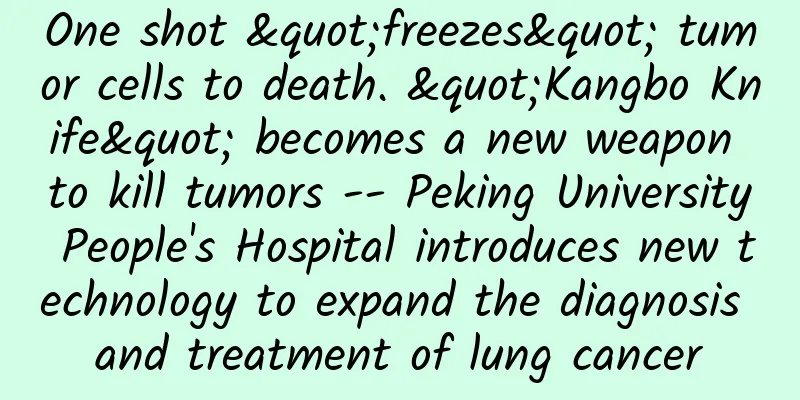One shot "freezes" tumor cells to death. "Kangbo Knife" becomes a new weapon to kill tumors -- Peking University People's Hospital introduces new technology to expand the diagnosis and treatment of lung cancer

|
Introduction: As a new minimally invasive treatment method, Kangbo Knife has shown unique advantages in the treatment of lung cancer. It uses a composite cold and hot ablation technology, which can accurately act on tumor tissue, effectively kill cancer cells, and protect surrounding normal tissues to the greatest extent. Recently, Peking University People's Hospital introduced a new type of ablation equipment - the combined cold and hot ablation system (also known as the Kangbo knife). The Department of Thoracic Surgery used this minimally invasive technology in the Tongzhou branch, and 16 lung cancer patients achieved significant results. The implementation of this technology also provides new treatment opportunities for lung cancer patients who are unwilling to undergo surgical resection and those who cannot undergo surgery in the middle and late stages. Minimally invasive ablation surgery brings more possibilities to cancer patients Lung cancer is one of the common malignant tumors. It is the malignant tumor with the fastest increasing incidence in my country in the past 30 years. It is currently the malignant tumor with the highest incidence and mortality rate in my country, posing a serious threat to people's health and lives. For patients with early-stage lung cancer, surgery is the preferred treatment. However, some patients cannot tolerate surgery for various reasons, or cannot undergo surgery again due to postoperative recurrence or new tumors; or they have multiple primary lung cancers, and due to too many lesions, complete surgical resection will seriously damage lung function; for these patients, ablation therapy, as an effective supplement to surgery, can give patients the possibility of radical cure with almost no effect on lung function. Currently, tumor ablation technologies mainly include radiofrequency ablation, microwave ablation and cryoablation. Cryoablation technology can be used to treat a variety of solid tumors. Image-guided ablation for lung cancer and lung metastases has been recommended by multiple international and domestic clinical guidelines and consensus. From -196℃ to 80℃, tumors are melted in "deep water and fire" Kangbo Knife is an innovative composite hot and cold ablation surgical system independently developed in my country in 2018. It is mainly used for minimally invasive treatment of various solid tumors such as liver cancer and lung cancer. Although the Kangbo Knife is called a "knife", it is actually just an ablation needle with a diameter of only 2 mm. Under the guidance of CT or B-ultrasound images, it enters the targeted part of the tumor through percutaneous puncture. This ablation needle combines the functions of deep cryotherapy (minimum -196℃) and rapid rewarming (maximum 80℃), which can controllably cause the lesion tissue to undergo a complex treatment process such as cooling, freezing and rewarming, and can accurately act on the tumor tissue to achieve minimally invasive treatment. Hu Libao, deputy director of the Lung Cancer Center and deputy chief physician of the Department of Thoracic Surgery at Peking University People's Hospital, introduced: Specifically, the Kangbo Knife uses liquid nitrogen to reduce the temperature of the surrounding diseased tissue to more than 100 degrees below zero through the tip of the puncture needle, causing the inside and outside of the tumor cells, the microvenules and microarterioles to quickly "freeze", causing tumor cell lysis, small blood vessel damage and local hypoxia, thereby freezing the tumor cells to death, and then rewarming with alcohol to promote local tissue exudation, expand the next freezing range, and cause the remaining tumor cells to swell and rupture... This repeated alternation of hot and cold physical stimulation can repeatedly kill tumor tissue cells, improve the thoroughness of the treatment, and achieve the purpose of treating tumors. Painless tumor removal, easy treatment to achieve "cure" Compared with radiofrequency ablation and microwave ablation, Cryoablation with the Kangbo Knife not only has the advantages of less trauma, fewer side effects, and faster recovery, but also causes less local pain. It is suitable for patients with tumors "adjacent" to pain-sensitive areas, such as patients with pleural ≤1 cm or tumors with bone metastasis causing bone destruction. Patients feel no pain during the treatment. Because this treatment method does not cause radiation or chemical damage, can be treated repeatedly, and can stimulate the body's immune response, enhance the ability to clear tumor cells, and thus improve the treatment effect, it is also called "green treatment technology." This technology is also suitable for patients with pacemakers and heart stents implanted in their bodies who are not suitable for radiofrequency ablation. As shown in the figure, the patient is a 64-year-old female who had a 6mm subpleural metastasis in the right lower lobe of the lung (the pleura is a pain-sensitive area, and the heating state during radiofrequency and microwave ablation stimulates the pleura, which can cause the patient to feel increased pain during the operation and make it difficult to persist). She underwent Conbokr cryoablation to accurately hit the lesion. The patient felt no pain throughout the operation. After the operation, CT scan showed that the ablation range completely covered the lesion, reaching the curative ablation range. Hu Libao pointed out that in clinical practice, for early-stage lung cancer or small tumors (lesions less than three centimeters), when patients are too old or weak to tolerate surgical resection, cryoablation can be used to completely necrotize local tumor tissue to achieve the purpose of cure. Patients treated with the Kangbo Knife do not need general anesthesia during the operation, and the pain after the operation is mild. They can get out of bed and move freely 24 hours after the operation. Indications for curative ablation include: (1) stage IA non-small cell lung cancer (NSCLC) ① patients cannot tolerate surgical resection due to poor cardiopulmonary function or advanced age; ② patients refuse surgical resection; ③ patients cannot tolerate or refuse reoperation due to new or residual nodules after surgical resection; ④ multiple primary NSCLC; ⑤ unilateral lung loss due to various reasons; ⑥ lesions do not meet the criteria for surgical resection, but the patient is severely anxious and cannot be relieved by medication or psychotherapy; (2) oligometastatic tumors in the lungs with good prognosis (less than 3 on one side, less than 5 on both sides, the maximum diameter of multiple lesions ≤ 3 cm, and the maximum diameter of a single lesion on one side ≤ 5 cm). The patient was a 66-year-old female with a 1.4×1.1cm mixed ground-glass nodule in the right upper lobe. Due to poor cardiopulmonary function, she could not tolerate surgery. During the ablation, a puncture biopsy was performed simultaneously, and adenocarcinoma was diagnosed. Two years after the ablation, a CT scan was performed again, and the surgical area showed linear shadows, indicating that the lung cancer was cured. Palliative ablation to maximize the patient's survival In the treatment of tumors, the Combo Knife can be used alone or in combination with surgery or chemotherapy. For some advanced tumors, cryoablation can be used as a palliative treatment. Palliative ablation, as an important component of comprehensive treatment, can alleviate the symptoms caused by tumors and improve patients' lives to the greatest extent, helping patients reduce tumor burden, relieve symptoms, prolong survival, and improve quality of life. Its indications include: for patients with a maximum tumor diameter of more than 5 cm or with more than 3 lesions in one lung (more than 5 in both lungs), when a single treatment cannot completely ablate the tumor, multiple needles, multiple points or fractionated treatments can be performed, or combined with other treatment methods. If the tumor invades the ribs or vertebrae and causes refractory or intractable pain, ablation of the local bone invasion of the tumor (or combined with other treatment methods such as bone cement) can achieve analgesic effects. The patient was a 66-year-old female with a 1.4×1.1cm mixed ground-glass nodule in the right upper lobe. Due to poor cardiopulmonary function, she could not tolerate surgery. During the ablation, a puncture biopsy was performed simultaneously, and adenocarcinoma was diagnosed. Two years after the ablation, a CT scan was performed again, and the surgical area showed linear shadows, indicating that the lung cancer was cured. Patients treated with the Kangbo knife do not need general anesthesia during the operation, experience mild pain after the operation, and can get out of bed and move around freely after 24 hours. Expert Tips: After Kangbo Knife treatment, patients need to pay attention to the following aspects: regular follow-up and re-examination CT to monitor the treatment effect and tumor changes, regular work and rest, appropriate exercise to maintain good living habits, psychological adjustment and emotional management, especially pay attention to physical reactions and abnormal conditions, and go to the hospital as soon as possible if chest tightness, shortness of breath, chest pain and other discomforts occur. Expert introduction—— Hu Libao, a doctor of medicine from Peking University, is the deputy director of the Lung Cancer Center of Peking University People's Hospital and an associate chief physician of thoracic surgery. He is responsible for the interventional treatment of thoracic diseases and is good at percutaneous biopsy and ablation treatment of thoracic tumors, preoperative puncture localization of small lung nodules, transarterial chemoembolization of lung cancer and solid tumors, hemoptysis and interventional embolization treatment of pulmonary arteriovenous malformations, etc. Department of Thoracic Surgery Visit information: 1. Xizhimen Campus: Expert outpatient clinic and specialized outpatient clinic (interventional treatment for lung cancer) on Tuesday afternoon, special outpatient clinic on Sunday afternoon 2. Tongzhou Campus: Special outpatient clinic on Wednesday morning Contributor: Hu Libao, Department of Thoracic Surgery (Worker No. 04315) Editor: Zhong Yanyu, Publicity Center |
>>: It’s spring now. What should patients with hypertension pay attention to?
Recommend
What are the fetal movements at six months of pregnancy?
For pregnant mothers, the fetus in the belly grow...
What should I pay attention to when drinking milk and coffee before drinking? What are the taboos of coffee and tea?
The caffeine in coffee can increase the excitabil...
How to cure sagging breasts?
Every woman has extremely high requirements for h...
2 months pregnant with some blood in vaginal discharge
The color of leucorrhea is the easiest way to ide...
Is brown sugar cubes delicious when soaked in water? How to store brown sugar cubes
Brown sugar has a fresh scent of sucrose, no pecu...
What is the cause of inverted nipples?
Nipple inversion can be divided into true inversi...
What causes pain in the vagina
If some women do not pay enough attention in thei...
Why do I get butterfly spots when I'm pregnant with a daughter?
Pregnant women will develop stretch marks during ...
How to practice Ba Duan Jin for better results? How long should I practice Ba Duan Jin for it to be effective?
Ba Duan Jin is a colorful treasure among traditio...
Can I eat Zhi during my menstrual period?
Menstruation is a special period for women. Many ...
Physiological effects of estrogen on the uterus
What is the physiological effect of estrogen on t...
Why can't we eat flounder? What are the taboos of eating flounder?
In the market, we see that the head and body of f...
Abdominal pain like diarrhea in late pregnancy
Some women experience abdominal pain similar to d...
What color is lochia?
Women always have this kind of situation after gi...
Use ginger for thinning hair on forehead
Compared with boys, girls care more about their a...









